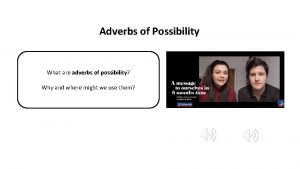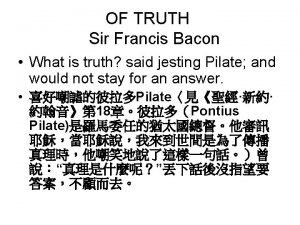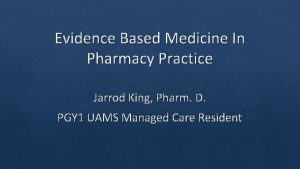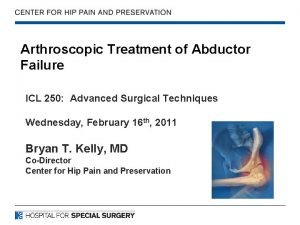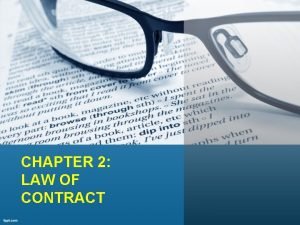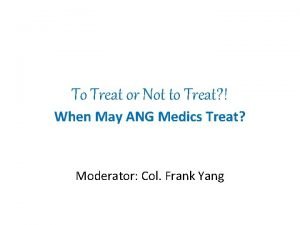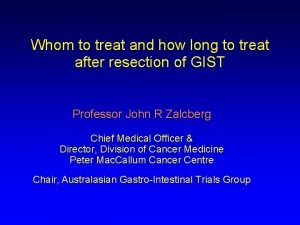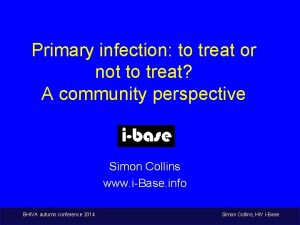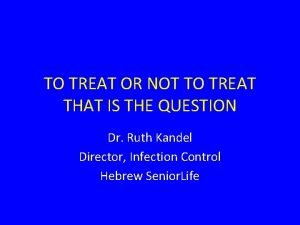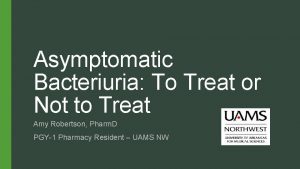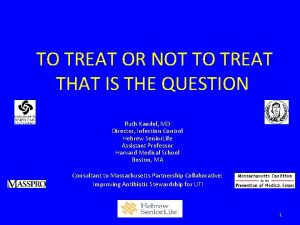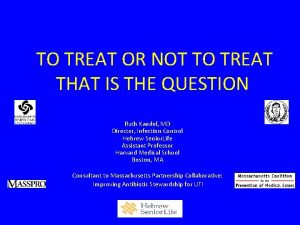Treat everyone with sincerity they will certainly appear

















- Slides: 17

Treat everyone with sincerity, they will certainly appear likeable and friendly. 1 Survival Analysis

Survival Analysis Parametric Regression Models 2 Survival Analysis

Abbreviated Outline Proportional hazards (PH) modeling ¢ Accelerated failure time (AFT) modeling ¢ Diagnosis for models/ model selection ¢ 3 Survival Analysis

Notation Y: survival time ¢ X: covariate vector ¢ hx(y): the hazard function of Y given X ¢ Sx(y): the survival function of Y given X ¢ Yx: Y given X ¢ 4 Survival Analysis

Proportional Hazards Model hx(y) = h 0(y)*g(X) Hazard function of Y given X Baseline hazard function A positive function Common choice of g(x): 5 Survival Analysis

Accelerated Failure Times Model Yx * g(X) = Y 0 Sx(y) = S 0(yg(X)) Baseline survival function Common choice of g(x): 6 Survival Analysis

Notes ¢ AFT model = PH model if and only if the survival time is Weibull distributed. ¢ A more robust (semi-parametric) method has been developed for the PH model and so fitting the parametric PH model will not be demonstrated here. 7 Survival Analysis

Several AFT Models ¢ Weibull AFT model ¢ Log-logistic AFT model ¢ Log-normal AFT model ¢ Generalized Gamma AFT model 8 Survival Analysis

Model Diagnosis SAS reference: SAS textbook Chapter 4 1. Checking the parametric model for Y 2. Residual analysis 9 Survival Analysis

Model Diagnosis Checking the model for Y: ¢ If no censored observations, use Q-Q plots. ¢ If with censored observations, use probability plot (SAS option PROBPLOT in PROC LIFEREG) 10 Survival Analysis

Graphical Methods for Model Diagnosis Exponential model ¢ Weibull model ¢ Lognormal model ¢ Log logistic model (exercise) ¢ Note: these methods do not take covariates into account; must be done by groups 11 Survival Analysis

Model Diagnosis Checking the AFT model: 1. Fit Kaplan-Meier method to each group separately 2. Compute a sequence of percentiles for each group 3. Draw the Q-Q plot, percentile of one group vs. that of another group 4. “almost linear” implies AFT model 12 Survival Analysis

Initial Model Selection Which parametric AFT model (with all covariate) to start with: For nested models: use likelihood ratio test (See SAS textbook p. 89 for details and examples) ¢ Otherwise, use AIC (See Klein Sec. 12. 4) ¢ 13 Survival Analysis

Final Model Selection Fit the initial model ¢ Conduct backward model selection by L-R tests ¢ 14 Survival Analysis

Residual Analysis ¢ Cox-Snell residual: and are i. i. d. exp(1). 15 Survival Analysis

Residual Analysis ¢ The Cox-Snell residuals form a right censored dataset and it must follow the exponential distribution with mean one if the model fits the data right ¢ The residual analysis is NOT sensitive to the difference in model fit. 16 Survival Analysis

Summary 1. 2. 3. 4. 5. Fit AFT model including all covariates based on the Lognormal, log-logsitic, Weibull and Generalized Gamma models for Y (totally 3 models) Use LR tests/AIC to determine your initial model Do backward model selection to identify your final model Conduct residual analysis If it fits, write the fitted final model and interpret the model/describe the effects of covariates. 17 Survival Analysis
 Treated with sincerity
Treated with sincerity Mffmm
Mffmm How do we treat the life the life how we treat
How do we treat the life the life how we treat Good afternoon to you all
Good afternoon to you all Adverbs of posibility
Adverbs of posibility Certain factor
Certain factor Certainly there be that delight in giddiness
Certainly there be that delight in giddiness How does juliet treat paris when they meet
How does juliet treat paris when they meet Social business letter
Social business letter Act 2 scene 4 summary romeo and juliet
Act 2 scene 4 summary romeo and juliet How to calculate number needed to treat
How to calculate number needed to treat What did jay gould do with his money
What did jay gould do with his money Chapter 4 section 3 the persian empire
Chapter 4 section 3 the persian empire Who is mr. kirwin and how does he treat victor?
Who is mr. kirwin and how does he treat victor? Why were the nuns’ faces “pinched with displeasure”?
Why were the nuns’ faces “pinched with displeasure”? How to treat bursitis in the hip
How to treat bursitis in the hip Guthing vs lynn case
Guthing vs lynn case Environmental problems
Environmental problems




